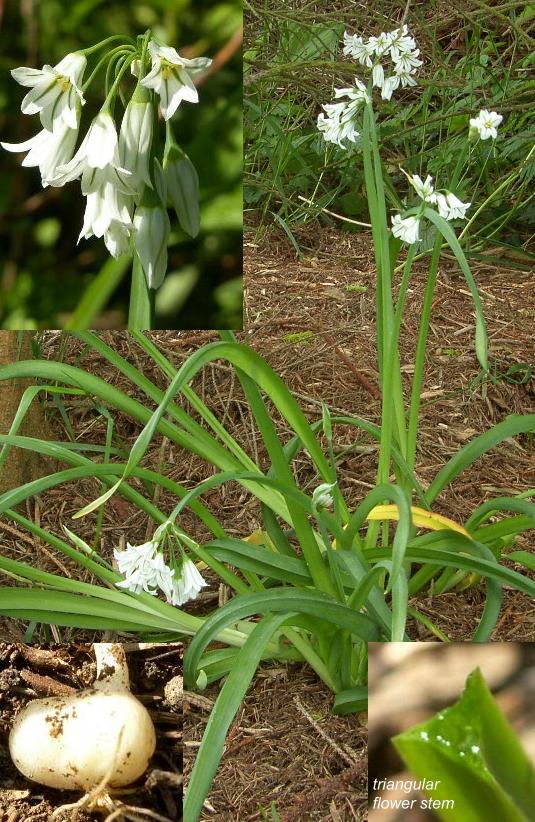Three-cornered LeekScientific Name: Allium triquetrum |
The Three-cornered Leek is very invasive due to the seed it produces which germinates easily to create a dense clump of leaves and flowers. In the larger garden it makes an attractive display in a woodland setting. It is a native of the Mediterranean, and is now naturalised in many parts of the British Isles, but as it is listed as an invasive non-native species in Schedule 9 of the Wildlife and Countryside Act, it is an offence to allow it to grow in the wild in England and Wales. It prefers shady areas, but is fairly tolerant of most conditions.
The leaves are mid-green and hairless with a keel running up one side to make them more rigid. They emerge in spring and die away after flowering. As with all Alliums it forms a bulb as an underground storage unit when the leaves die away. The white bulbs reproduce vegetatively by dividing. The one shown in the inset is deformed by the presence of a developing bulb - they are usually spherical.
The flowers appear from April to May, carried on a stalk which is triangular and gives the plant its name. They are white with a green stripe in the centre of the petals, in a one-sided umbel with between 4 to 10 to each flower head. (They could be mistaken for the white form of Bluebells, but the odour will distinguish them). Both male and female parts are present in each flower, and they are pollinated by Bees and insects. The black oblong seeds fall mainly close to the parent plant at maturity, but can be carried further afield by nearby waterways or by ants. They germinate to form tiny bulblets near to the surface which are drawn downwards by the roots in subsequent years.
All parts of the plant are edible. The leaves and flowers can be added to salads, and the bulbs can be substituted for Garlic (see recipes in Ramsons monograph. It is not usually mentioned as health giving, but other members of the genus are, so A. triquetrum can probably be added to the list. Care should be taken if picking as the leaves can easily be mistaken for those of many other bulbous plants which can be posionous, eg. Daffodils; the flowers are also similar to the white form of the Bluebell. The triangular flower stalk and characteristic odour are the best identifiers.
The juice of the plant is said to deter moles and moths.
Digging it up is not usually successful straight away as there are many seeds and bulblets which are tiny and difficult to remove completely. Over a number of years, continual cutting should eventually exhaust the bulbs and the reservoir of seeds. Any uprooted bulbs should not be added to the compost heap, and care should be taken if moving plants or soil from an infested area.
A systemic weedkiller such as Glyphosate applied in the spring before flowering, should eradicate it. Allow the leaves to grow well to give more area for absorbtion and the surface of the leaves is waxy so lightly trampling them first should increase uptake. A selective agent containing 2,4D, Dicamba and Mecoprop (MCPP) should also be effective as there are reports of success with a close relative the Wild Onion (Allium canadense) which tends to invade grassed areas. Re-treatment will be necessary due to persistence of the bulbs and the reservoir of seeds.
See also Ramsons or Wild Garlic, which has a similar odour, flowers and is quite invasive.
Follow these links for further details on Weeds, Weed Removal and Weed Prevention.
